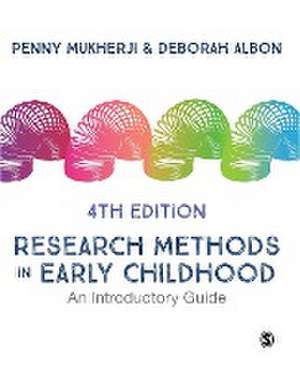Research Methods in Early Childhood
Autor Penny Mukherji, Deborah Albonen Limba Engleză Paperback – 31 dec 2022
| Toate formatele și edițiile | Preț | Express |
|---|---|---|
| Paperback (1) | 238.77 lei 3-5 săpt. | +33.46 lei 7-11 zile |
| SAGE Publications Ltd – 31 dec 2022 | 238.77 lei 3-5 săpt. | +33.46 lei 7-11 zile |
| Hardback (2) | 534.98 lei 6-8 săpt. | |
| SAGE Publications – 29 ian 2018 | 534.98 lei 6-8 săpt. | |
| SAGE Publications Ltd – 31 dec 2022 | 696.74 lei 6-8 săpt. |
Preț: 238.77 lei
Nou
Puncte Express: 358
Preț estimativ în valută:
45.69€ • 47.71$ • 37.73£
45.69€ • 47.71$ • 37.73£
Carte disponibilă
Livrare economică 25 martie-08 aprilie
Livrare express 11-15 martie pentru 43.45 lei
Preluare comenzi: 021 569.72.76
Specificații
ISBN-13: 9781529732955
ISBN-10: 1529732956
Pagini: 448
Dimensiuni: 191 x 235 x 24 mm
Greutate: 0.76 kg
Ediția:4. Auflage
Editura: SAGE Publications Ltd
ISBN-10: 1529732956
Pagini: 448
Dimensiuni: 191 x 235 x 24 mm
Greutate: 0.76 kg
Ediția:4. Auflage
Editura: SAGE Publications Ltd
Notă biografică
Penny Mukherji has been involved in educating students in the field of early childhood for 30 years and during this time has developed a deep understanding of how to support students on their learning journeys. Before her retirement Penny was a Senior Lecturer in Early Childhood Studies at London Metropolitan University, where an important part of her teaching involved supporting both undergraduate and postgraduate students completing their research projects. Penny continues to be actively involved in the university, both as a tutor for students who are distance learners and as a supervisor for students completing their dissertations. With a background in health and psychology, Penny is an established author, with a special interest in the health and well-being of young children.
Cuprins
PART I: PLANNING YOUR RESEARCH STUDY
Chapter 1: Research Design
Chapter 2: The Research Proposal
Chapter 3: Reviewing the Literature
PART II: PARADIGMS AND PRINCIPLES
Chapter 4: Positivist Research
Chapter 5: Beyond Positivism: Interpretivism, 'Critical' Paradigms and Post-structuralism
Chapter 6: Ethics
Chapter 7: Listening to Young Children
PARET III: APPROACHES TO RESEARCH
Chapter 8: Surveys
Chapter 9: Ethnography
Chapter 10: Case Studies
Chapter 11: Action Research
PART IV: METHODS
Chapter 12: Observation
Chapter 13: Interviews
Chapter 14: Questionnaires
Chapter 15: Using Documents and Visual Texts
Chapter 16: Journaling as a Research Tool
Chapter 17: Creative Methods for Listening to Children in Research
PART V: ANALYSING AND SHARING YOUR FINDINGS
Chapter 18: Analysing and Presenting Data
Chapter 19: Writing Up and Sharing Your Findings
Chapter 1: Research Design
Chapter 2: The Research Proposal
Chapter 3: Reviewing the Literature
PART II: PARADIGMS AND PRINCIPLES
Chapter 4: Positivist Research
Chapter 5: Beyond Positivism: Interpretivism, 'Critical' Paradigms and Post-structuralism
Chapter 6: Ethics
Chapter 7: Listening to Young Children
PARET III: APPROACHES TO RESEARCH
Chapter 8: Surveys
Chapter 9: Ethnography
Chapter 10: Case Studies
Chapter 11: Action Research
PART IV: METHODS
Chapter 12: Observation
Chapter 13: Interviews
Chapter 14: Questionnaires
Chapter 15: Using Documents and Visual Texts
Chapter 16: Journaling as a Research Tool
Chapter 17: Creative Methods for Listening to Children in Research
PART V: ANALYSING AND SHARING YOUR FINDINGS
Chapter 18: Analysing and Presenting Data
Chapter 19: Writing Up and Sharing Your Findings
Descriere
Descriere de la o altă ediție sau format:
This textbook provides a clear and comprehensive guide to the different types of research methods, with a particular focus on how these methods can be used in early childhood. Using examples, case studies and reflection points, the book then illustrates how to translate theory into practice.
This textbook provides a clear and comprehensive guide to the different types of research methods, with a particular focus on how these methods can be used in early childhood. Using examples, case studies and reflection points, the book then illustrates how to translate theory into practice.
